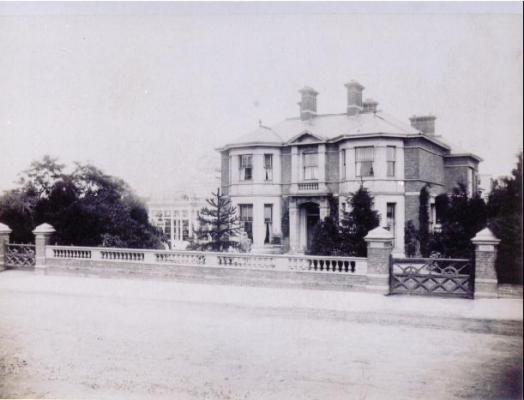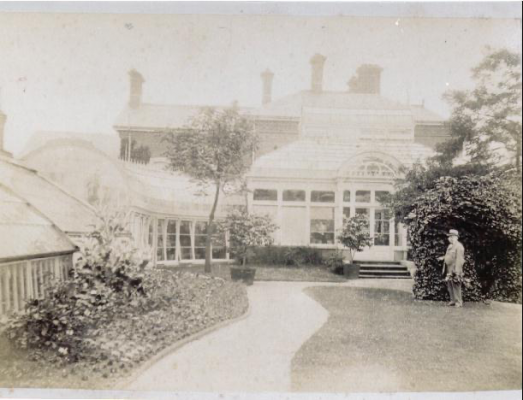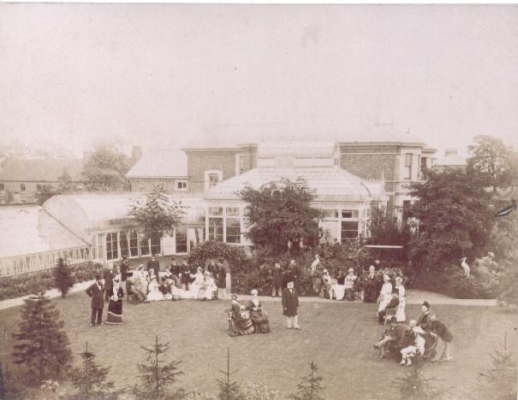AndyC
Member
- Messages
- 9
- Location
- Market Harborough
Hi All, I love to get your insight on a few things, regarding my ongoing battle with damp...
Situation:
We have 2 internal walls with damp, in our ground level dining room. Both walls are solid brick with no insulation, lime plaster internally (mostly...), and painted brick externally, with a chemical injection damp proof course, applied to the bricks (!), not the mortar.
To date we've fixed our roof, replacing all guttering to ensure rainwater is draining away correctly - I'm pretty confident this part of the equation is now resolved.
We've removed the wallpaper internally to reveal a series of bodge-job fixes over who-knows how many years, including patches of modern non permeable plaster, rubbery type sealants (internally), blocks of wood & breeze block fragments in plaster... its a bit of a Frankenstein!
I have a plasterer ready to start that will remove all the blown plaster and other obstacles, taking back to brick where necessary, and redoing in lime.
However, I've just noticed following some recent rain, the exposed lime plaster is showing a lot of damp in the areas that had damp (previously covered in modern plaster) - which I would expect to be drying out nicely now that everything is 'open'.
I'm now having a poke around outside at the external paint, which I'd noted was all bubbling and very old - but the mortar was OK. After removing some of the paint today I've discovered some bizarre wooden inserts in the mortar which look like they've been there for a very long time. Worth nothing that these are only in the 2 walls with issues. Given that they've been painted over, I'm thinking they might be acting like sponges, holding onto and channelling the moisture inwards.
I've looked into removing the external paint entirely by DOFF, but with quotes coming in at £20k+, theres simply no budget for it.
I did have a damp specialist have a look while the paper was still on the walls, and he thought that due to the shape of the damp looking like a temperature gradient it was being caused by a cold corners condensation / dew point etc., and not rising damp.
I intend to lift the floor adding underfloor insulation, and add a radiator to that side of the room to address the dew point issue.
Questions:
1. Has anyone seen these kind of wooden inserts being used in external brickwork before? Should I be removing and repointing? Or are they needed?
2. If I remove the bulk of the old external paint, is there a suitable masonry paint out there that allows everything to breathe?
3. Any other ideas on what might be contributing to the issues here?
Pics attached of internal corner, adjacent external wall with paint scraped off, and wooden inserts in mortar.
Many thanks!
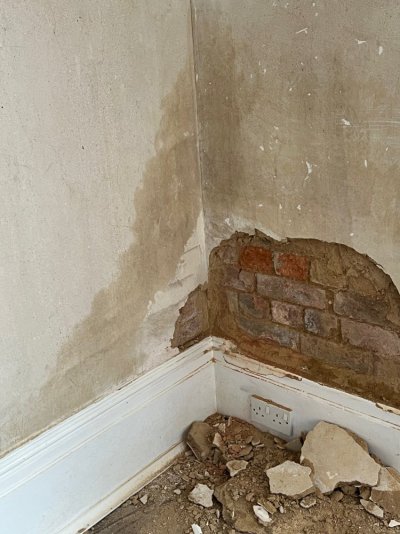
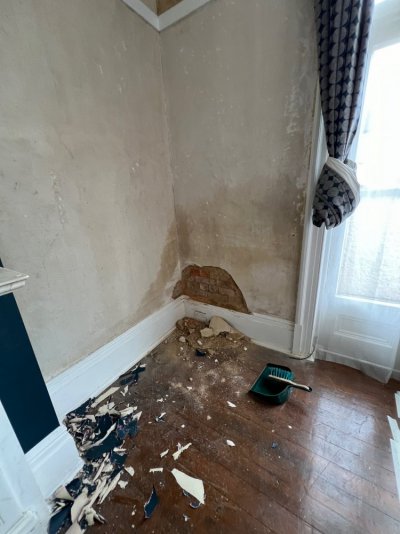
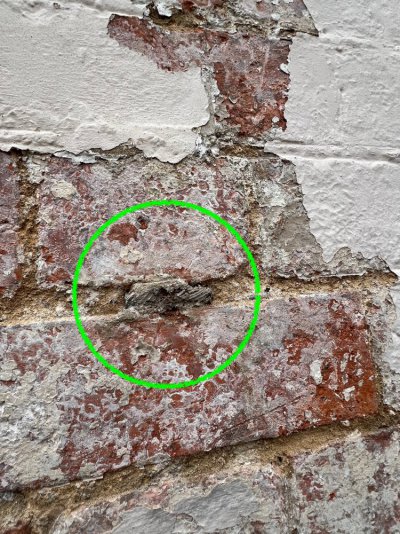
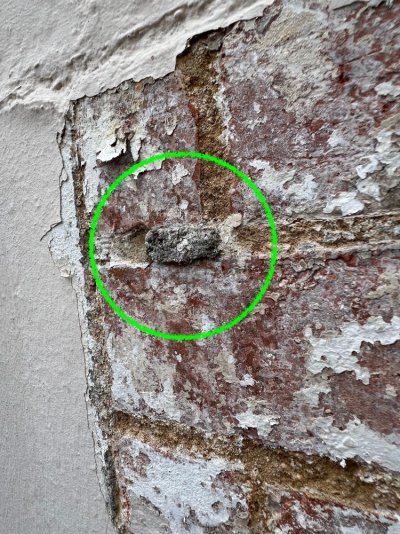
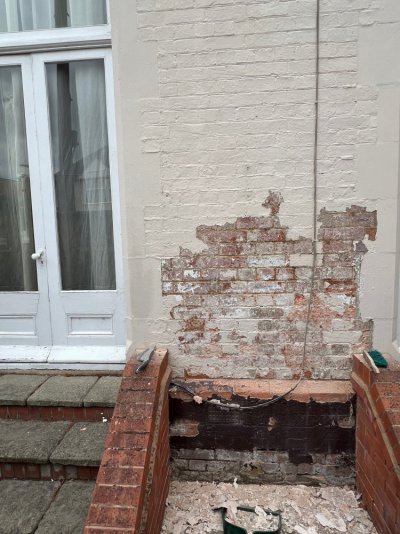
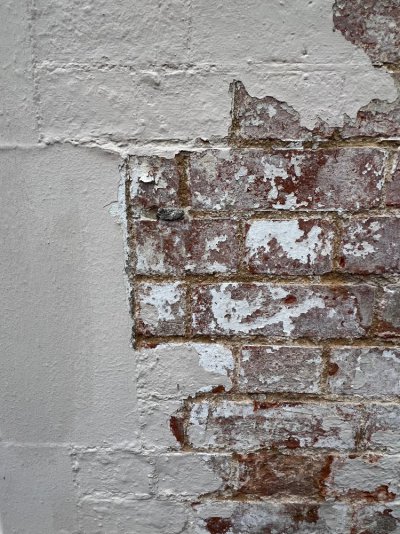
Situation:
We have 2 internal walls with damp, in our ground level dining room. Both walls are solid brick with no insulation, lime plaster internally (mostly...), and painted brick externally, with a chemical injection damp proof course, applied to the bricks (!), not the mortar.
To date we've fixed our roof, replacing all guttering to ensure rainwater is draining away correctly - I'm pretty confident this part of the equation is now resolved.
We've removed the wallpaper internally to reveal a series of bodge-job fixes over who-knows how many years, including patches of modern non permeable plaster, rubbery type sealants (internally), blocks of wood & breeze block fragments in plaster... its a bit of a Frankenstein!
I have a plasterer ready to start that will remove all the blown plaster and other obstacles, taking back to brick where necessary, and redoing in lime.
However, I've just noticed following some recent rain, the exposed lime plaster is showing a lot of damp in the areas that had damp (previously covered in modern plaster) - which I would expect to be drying out nicely now that everything is 'open'.
I'm now having a poke around outside at the external paint, which I'd noted was all bubbling and very old - but the mortar was OK. After removing some of the paint today I've discovered some bizarre wooden inserts in the mortar which look like they've been there for a very long time. Worth nothing that these are only in the 2 walls with issues. Given that they've been painted over, I'm thinking they might be acting like sponges, holding onto and channelling the moisture inwards.
I've looked into removing the external paint entirely by DOFF, but with quotes coming in at £20k+, theres simply no budget for it.
I did have a damp specialist have a look while the paper was still on the walls, and he thought that due to the shape of the damp looking like a temperature gradient it was being caused by a cold corners condensation / dew point etc., and not rising damp.
I intend to lift the floor adding underfloor insulation, and add a radiator to that side of the room to address the dew point issue.
Questions:
1. Has anyone seen these kind of wooden inserts being used in external brickwork before? Should I be removing and repointing? Or are they needed?
2. If I remove the bulk of the old external paint, is there a suitable masonry paint out there that allows everything to breathe?
3. Any other ideas on what might be contributing to the issues here?
Pics attached of internal corner, adjacent external wall with paint scraped off, and wooden inserts in mortar.
Many thanks!







